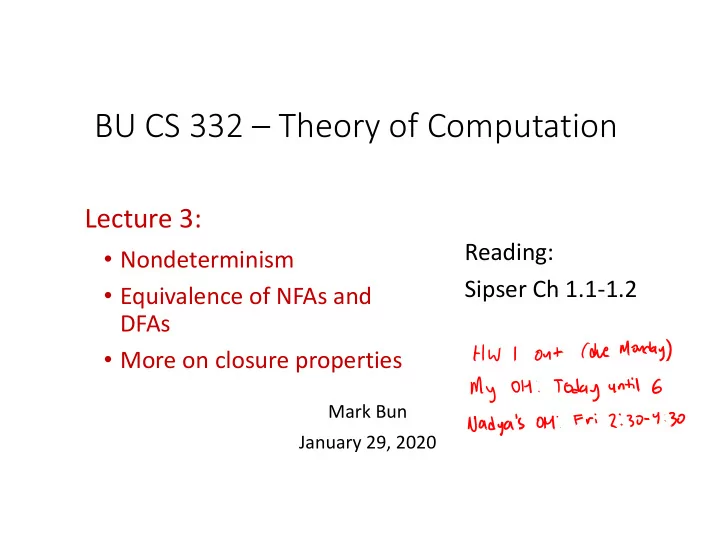

BU CS 332 – Theory of Computation Lecture 3: Reading: • Nondeterminism Sipser Ch 1.1 ‐ 1.2 • Equivalence of NFAs and DFAs • More on closure properties Mark Bun January 29, 2020
Non Nondeterminism 1 0,1 0 0 0 1 1 A Nondeterministic Finite Automaton (NFA) accepts if there is a way to make it reach an accept state. 1/29/2020 CS332 ‐ Theory of Computation 2
Non Nondeterminism 1 0,1 0 0 0 1 1 Example: Does this NFA accept the string 1100? 1/29/2020 CS332 ‐ Theory of Computation 3
Some special transitions 0 0, 1 1 1/29/2020 CS332 ‐ Theory of Computation 4
Example 1 0 0 1/29/2020 CS332 ‐ Theory of Computation 5
Example 0,1 0,1 0, 1 1 1/29/2020 CS332 ‐ Theory of Computation 6
Formal Definition of a NFA An NFA is a 5 ‐ tuple 0 is the set of states is the alphabet is the transition function � 0 is the start state is the set of accept states accepts a string if there exists a path from 0 to an accept state that can be followed by reading . 1/29/2020 CS332 ‐ Theory of Computation 7
Example 1 𝟓 𝟑 0 𝟏 𝟏 𝟒 𝟏 , 𝟐 𝟑 𝟒 𝟓 0 𝟓 𝟐 𝟑 𝟒 1/29/2020 CS332 ‐ Theory of Computation 8
Example 0,1 0,1 0, 1 1 𝟐 𝟒 𝟏 𝟑 𝟏 𝟏 𝟏 , 𝟐 𝟑 𝟒 𝟏 𝟐 𝟑 𝟒 1/29/2020 CS332 ‐ Theory of Computation 9
Nondeterminism Deterministic Nondeterministic Computation Computation Ways to think about nondeterminism • (restricted) parallel computation reject • tree of possible computations • guessing and verifying the “right” choice accept accept or reject 1/29/2020 CS332 ‐ Theory of Computation 10
Why study NFAs? • Not really a realistic model of computation: Real computing devices can’t really try many possibilities in parallel But: • Useful tool for understanding power of DFAs/regular languages • NFAs can be simpler than DFAs • Lets us study “nondeterminism” as a resource (cf. P vs. NP) 1/29/2020 CS332 ‐ Theory of Computation 11
NFAs can be simpler than DFAs A DFA that recognizes the 0,1 language : 0 1 0,1 An NFA that recognizes the language : 1 1/29/2020 CS332 ‐ Theory of Computation 12
Sometimes DFAs mu must st be larger Theorem. Every DFA for the language must have at least 3 states. Proof: 1/29/2020 CS332 ‐ Theory of Computation 13
Equivalence of NFAs and DFAs 1/29/2020 CS332 ‐ Theory of Computation 14
Equivalence of NFAs and DFAs Every DFA is an NFA, so NFAs are at least as powerful as DFAs Theorem: For every NFA , there is a DFA such that Corollary: A language is regular if and only if it is recognized by an NFA 1/29/2020 CS332 ‐ Theory of Computation 15
Equivalence of NFAs and DFAs (Proof) Let be an NFA 0 0 recognizing Goal: Construct DFA Intuition: Run all threads of in parallel, maintaining the set of states where all threads are. reject Formally: “The Subset Construction” accept 1/29/2020 CS332 ‐ Theory of Computation 16
NFA ‐ > DFA Example 1 a b 1/29/2020 CS332 ‐ Theory of Computation 17
Subset Construction (Formally) Input: NFA 0 0 Output: DFA for all and . 0 1/29/2020 CS332 ‐ Theory of Computation 18
0,1 NFA ‐ > DFA Example ε 0 3 1 2 1 1/29/2020 CS332 ‐ Theory of Computation 19
Subset Construction (Formally) Input: NFA 0 0 Output: DFA for all and . �∈� 0 0 contains some accept state of 1/29/2020 CS332 ‐ Theory of Computation 20
Proving the Construction Works Claim: For every string , running on leads to state There exists a computation of on input ending at Proof idea: By induction on 1/29/2020 CS332 ‐ Theory of Computation 21
Historical Note Subset Construction introduced in Rabin & Scott’s 1959 paper “Finite Automata and their Decision Problems” 1976 ACM Turing Award citation For their joint paper "Finite Automata and Their Decision Problem," which introduced the idea of nondeterministic machines, which has proved to be an enormously valuable concept. Their (Scott & Rabin) classic paper has been a continuous source of inspiration for subsequent work in this field. 1/29/2020 CS332 ‐ Theory of Computation 22
Is this construction the best we can do? state NFA into a � ‐ state Subset construction converts an DFA Could there be a construction that always produces, say, an � ‐ state DFA? Theorem: For every , there is a language � such that 1. There is an ‐ state NFA recognizing � . 2. There is no DFA recognizing � with fewer than � states. Conclusion: For finite automata, nondeterminism provides an exponential savings over determinism (in the worst case). 1/29/2020 CS332 ‐ Theory of Computation 23
Recommend
More recommend